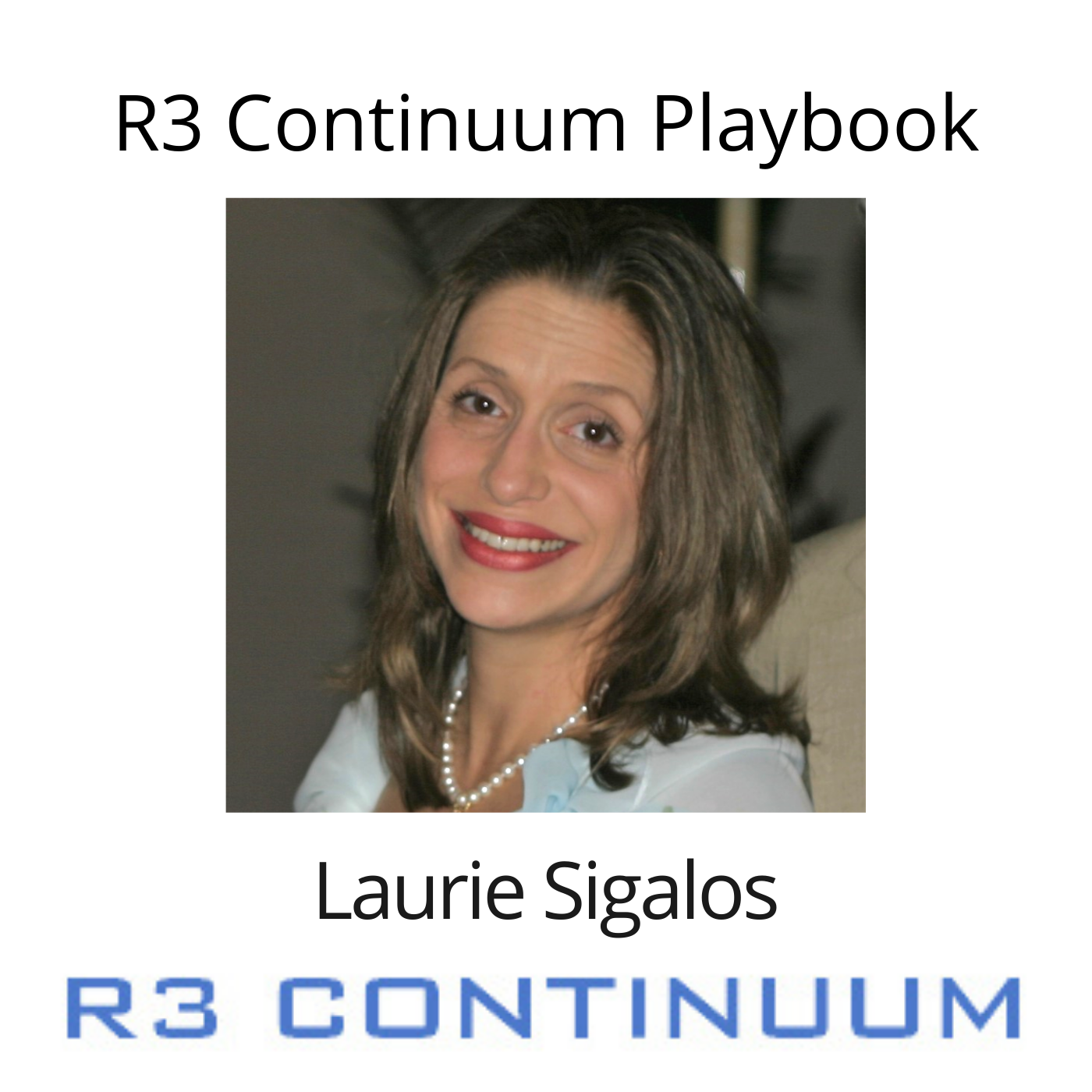
R3 Continuum Playbook: Executive Wellbeing
Laurie Sigalos, Director of Strategic Solutions at R3 Continuum, outlines ten ways leaders can address individual and collective stress in the workplace and make executive wellbeing a priority. The R3 Continuum Playbook is presented by R3 Continuum and is produced by the Minneapolis-St.Paul Studio of Business RadioX®. R3 Continuum is the underwriter of Workplace MVP, the show which celebrates heroes in the workplace.
TRANSCRIPT
Intro: [00:00:00] Broadcasting from the Business RadioX studios, here is your R3 Continuum Playbook. Brought to you by Workplace MVP sponsor, R3 Continuum, a global leader in workplace behavioral health, crisis and security solutions.
Laurie Sigalos: [00:00:13] Hello. I’m Laurie Sigalos, Director of Strategic Solutions at R3 Continuum. Today, we’ll be talking about executive wellness and what organizations should be mindful of while professionally and personally supporting their executives and employees. This past year and a half has certainly been challenging, especially with the demands placed upon us in conjunction with work-life balance.
Laurie Sigalos: [00:00:39] As a result of the pandemic, executives and their employees have experienced the miasma of cumulative stress. Given the circumstances and necessity of a predominantly virtual world, we have witnessed increased professional and personal isolation, decreased socialization, and increasing concerns for the overall wellness and behavioral health of executives, as well as their highly valued workforce. We’ve also experienced heightened anxiety, depression and an increase in substance use. As we transition back to in person workplaces and educational settings, we must prepare for what comes next in the workplace and with our families. The importance of well-being and self-care should truly be a priority for everyone.
Laurie Sigalos: [00:01:23] Now, I would like to spend time to impart 10 strategic solutions and practical approaches to help resolve these challenges. Executive wellness has gained increased attention in recent years. Executives are more cognizant and mindful of their own well-being while arduously seeking out effective strategies to increase resilience and cultivate healthier lifestyles. With this in mind, here are some helpful tips for executives to consider on both the professional and personal level. This is not an exhaustive list; however, we have seen a variety of actionable methods, which have been very helpful in our extensive work with executives around COVID-19 and the unprecedented adversity during the past few years.
Laurie Sigalos: [00:02:09] Number one: Make a commitment to always begin with positive intent. Take actions to model and support good conduct. Challenge yourselves as executives and senior leaders to have ownership of a healthy, thriving organizational culture physically, cognitively, emotionally and behaviorally. Be accountable for the results. Be open. Genuinely address concerns from an empathic stance.
Laurie Sigalos: [00:02:36] Number two: Destigmatize behavioral health issues in the workplace. Make the connection between culture of empathy and acceptance. The bottom line here – companies with high engagement have increased employee retention, are more profitable, have higher customer loyalty and much lower attrition.
Laurie Sigalos: [00:02:55] Number three: Implement coaching programs to augment senior leadership skills as they foster integrity and accountability. Continue to be flexible with time-off for executives and their teams, allowing them to take time as needed, rather than adhering to set dates and amounts of days each year for self-care purposes.
Laurie Sigalos: [00:03:14] Number four: Have a mutual, respectful set of attitudes, norms and beliefs amongst the executives when it comes to well-being. Emphasize preventative well-being screening for executives and their employees. Encourage and endorse prevention programs that enhance individual health and well-being on a holistic level, addressing both physical and behavioral health.
Laurie Sigalos: [00:03:36] Number five: Pilot behavioral health solutions first in full subsets of your leadership, and use the benefits they experience to get buy-in from the C-suite. Proactively cultivate an environment of well-being with diversity, equity and inclusion. Talk openly about the importance of behavioral health and wellness. Encourage executive leadership to model self-care.
Laurie Sigalos: [00:03:59] Number six: Use a concierge approach with expert providers who are accustomed to accommodating executive schedules, little private access services. Ensure privacy and confidentiality. Continue to offer virtual support options, such as telephonic secure video conferencing and email or text support.
Laurie Sigalos: [00:04:19] Number seven: Make all behavioral health offerings, including those at the executive level, visible to the organization. They can certainly go a long way towards creating a culture of well-being and inclusion. Train executives on the link between well-being and individual business performance to obtain engagement. Proactively increase behavioral health literacy and awareness with training curated specifically to your culture.
Laurie Sigalos: [00:04:44] Number eight: Amplify utilization with innovative performance programming to support executives during the most challenging times. Have a comprehensive plan in place to facilitate linkage to top-gear resources for issues that arch.
Laurie Sigalos: [00:04:59] Number nine: Focus on awareness and early intervention to facilitate a connection to expert resources sooner. In an effort to mitigate potential behavioral health crises, select external partners willing to tailor solutions to your organization’s specific needs with providers who have extensive experience with diversity, equity and inclusion.
Laurie Sigalos: [00:05:20] Number ten: Finally, communicate. Research indicates a lack of communication often results in feeling undervalued, uninformed or out of the loop. Communicate often, showing appreciation for employees’ efforts, addressing challenges and celebrating successes. Employees who are engaged and feel part of the organization are much less likely to feel burnout. The well-being and supportive presence of executives has the potential to be a competitive advantage. Enhance executive well-being by implementing a trickle-down approach with the assistance of education, support and consultative resources. Remember, we must care for ourselves in order to care for others.
Laurie Sigalos: [00:06:03] I hope you have found these tips to be helpful as you move forward with the renewed determination to be more mindful of well-being, caring for yourself and others. If you’re interested in additional information for yourself or colleagues, please feel free to reach out to us at wwww.r3c.com or email us at info@r3c.com. As experts in behavioral health and workplace solutions, my colleagues and I would be happy to have discussions with you regarding any current or anticipated challenges you may encounter. Thank you so much for your time. I hope you have a great day.
Show Underwriter
R3 Continuum (R3c) is a global leader in workplace behavioral health and security solutions. R3c helps ensure the psychological and physical safety of organizations and their people in today’s ever-changing and often unpredictable world. Through their continuum of tailored solutions, including evaluations, crisis response, executive optimization, protective services, and more, they help organizations maintain and cultivate a workplace of wellbeing so that their people can thrive. Learn more about R3c at www.r3c.com.
R3 Continuum is the underwriter of Workplace MVP, a show which celebrates the everyday heroes–Workplace Most Valuable Professionals–in human resources, risk management, security, business continuity, and the C-suite who resolutely labor for the well-being of employees in their care, readying the workplace for and planning responses to disruption.
Connect with R3 Continuum: Website | LinkedIn | Facebook | Twitter















